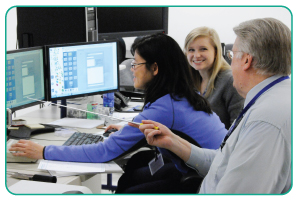McCrone Associates Scientist Appointed to National Forensic Science Standards Committee
Scientist Wayne Niemeyer Will Advise on National
Forensic Standards and Guidelines for Gunshot Residue Analysis
Westmont, IL (November 18, 2014) –The Organization for Scientific Area Committee (OSAC) appointed Wayne Niemeyer to its Subcommittee on Gunshot Residue, one of five Scientific Area Committee areas focusing on Chemistry/Instrumental Analysis. Niemeyer is a senior research scientist for McCrone Associates, Inc., the analytical service division of The McCrone Group. OSAC is part of an initiative by the U.S. Commerce Department’s National Institute of Standards and Technology (NIST) and the Department of Justice (DOJ) to strengthen forensic science in the United States.

Wayne Niemeyer instructs students on SEM techniques in the Gunshot Residue Identification course at Hooke College of Applied Sciences |
The Subcommittee on Gunshot Residue “will focus on standards and guidelines related to analyses of evidence that results from the deposition of or physical transfer of small or minute quantities of gunshot residue,” according to the OSAC website.
In June 2014, as part of its efforts to improve the scientific basis of forensic evidence used in courts of law, NIST and the DOJ created the first Forensic Sciences Standard Board (FSSB), replacing an ad hoc system. Niemeyer is one of 402 experts named to serve on 23 subcommittees of the five Scientific Area Committees on Biology/DNA, Chemistry/Instrumental Analysis, Crime Scene/Death Investigation, Digital/Multimedia and Physics/Pattern Interpretation. The 20 members on the Subcommittee on Gunshot Residue will determine appropriate standards, test methods, and requirements for lab accreditation, and advise OSAC’s FSSB. Members normally serve three-year terms.
Niemeyer joined McCrone Associates in 1992. He has 18 years of experience conducting GSR analysis using the scanning electron microscope and energy dispersive spectrometer. He became a charter member of the Scientific Working Group for Gunshot Residue in 2007 where he served as the Instrumentation Committee Chair until 2014. He is the lead instructor for the Gunshot Residue Identification course at Hooke College of Applied Sciences. He holds a chemistry degree from the Illinois Institute of Technology and a mathematics degree from DePaul University. Niemeyer is a member of American Society for Metals International.
“This is a huge undertaking by NIST/DOJ and I am honored to be selected to serve on the Subcommittee on Gunshot Residue with such distinguished colleagues,” Niemeyer said.
Niemeyer’s other areas of expertise include electrochemistry (corrosion), optical microscopy, scanning electron microscopy, electron microprobe analysis, infrared spectroscopy, lubrication and wear, waste water treatment, secondary ion mass spectrometry, x-ray photoelectron spectroscopy, conversion coatings on aluminum and steel surfaces, paint adhesion failure analysis, metallography, and other forensic applications of the SEM.
Information regarding OSAC may be found at http://www.nist.gov/forensics/osac/.